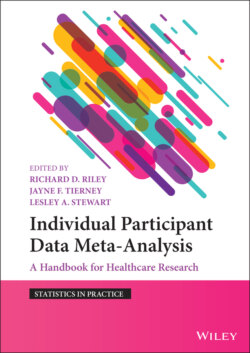Читать книгу Individual Participant Data Meta-Analysis - Группа авторов - Страница 61
3.9 Obtaining Funding
ОглавлениеThere are three main funding routes: funding as part of a core research programme, investigator‐led applications and commissioned calls from funders. Each of these has its own advantages and challenges.
It can be difficult to predict how much IPD will be available, what condition it will be in when it arrives, or how much time will be needed to negotiate collaboration and receive IPD. It is therefore perhaps most straightforward for IPD meta‐analysis projects to be funded as part of a core evidence synthesis research programme (or unit), which allows the research team to work across different IPD meta‐analyses (and other projects) running to differing schedules and to exercise flexibility on start and end dates. A similar approach is to embed the IPD project (undertaken by a suitably experienced and qualified team) within a larger long‐term programme of research in a particular topic area.
For investigator‐led applications for a single IPD meta‐analysis project, whilst time can be taken to build the project scope, explore possible collaborations and assess feasibility, a challenge may be in explaining the rationale for why an IPD synthesis is required rather than a standard review of existing aggregate data (Chapter 2). As IPD projects are rare relative to standard systematic reviews, peer reviewers and funders may be unfamiliar with what they entail, and so careful exposition of methods and the benefits that the IPD approach will bring is essential. Detailed costs and their justification will also be needed. A survey of members of the Cochrane IPD Meta‐Analysis Methods Group exploring barriers and successes in applying for funding for IPD meta‐analysis projects identified six key themes as being important to funding applications and how they were received by funders.81 These were:
1 Originality, relevance and potential impact of the project
2 Explaining the importance of using IPD
3 Clear articulation of aims and methods
4 Likely availability of IPD from existing trials
5 Justification and supporting evidence for the level of resource requested
6 Experience of the research group undertaking the review
Clearly a number of these points apply to all funding applications, but issues around the rationale for using IPD (and justification of the associated level of resource) and about the likely availability of IPD require specific and detailed consideration and explanation. Providing evidence that key trials (especially the largest, most recent or highest‐quality trials) have pledged or already provided their IPD can be a persuasive element of a successful funding application. Power calculations, based on characteristics (such as number of participants, number of outcome events, and variance of participant‐level covariates) of those trials promising their IPD, can help persuade funders (and indeed the IPD project team themselves) that the endeavour is worth the investment (Chapter 12).33,49
Commissioned calls for IPD meta‐analysis projects are relatively rare but seem to be increasing in frequency. Here, the case for the IPD meta‐analysis per se may not need to be made in as much detail. However, the challenge of preparing a funding bid (which will include performing many of the preparatory steps outlined in this chapter) to a short deadline is substantial. One aspect that can be particularly tricky is the need to convince the funder that the project team will obtain sufficient IPD for credible analysis. For many IPD meta‐analysis projects, it is difficult to ascertain willingness to participate in the short period of time between a funding call and grant submission. Although trial investigators can be approached for in principle agreement to collaborate, it can be difficult to make a persuasive case until the project is established. Furthermore, there is potential for considerable confusion if several research teams making competing applications approach the same trial investigators for in principle support. Within a short time frame it is almost impossible to gain detailed knowledge of which IPD will be available, and there is no crude credibility threshold above and below which the project is deemed feasible or infeasible. As mentioned, a statistical power calculation may be helpful, but for commissioned calls this will most likely need to be made conditional on assuming that particular trials do provide their IPD (Chapter 12).49 This will require careful explanation in the application, and it may help to provide a range of power calculations based on different assumed IPD retrieval rates.
